
Ride the High Country is a 1962 American CinemaScope Western film directed by Sam Peckinpah and starring Randolph Scott, Joel McCrea, and Mariette Hartley. The supporting cast includes Edgar Buchanan, James Drury, Warren Oates, and Ron Starr. The film's script, though credited solely to veteran TV screenwriter N.B. Stone Jr., was – according to producer Richard E. Lyons – almost entirely the work of Stone's friend and colleague, William S. Roberts, and Peckinpah himself.
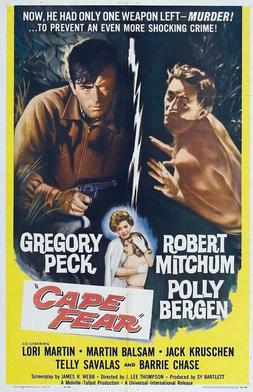
Cape Fear is a 1962 American psychological thriller directed by J. Lee Thompson, from a screenplay by James R. Webb, adapting the 1957 novel The Executioners by John D. MacDonald. It stars Gregory Peck as Sam Bowden, an attorney and family man who is stalked by a violent psychopath and ex-con named Max Cady, who is bent on revenge for Bowden's role in his conviction eight years prior. The film co-stars Polly Bergen and features Lori Martin, Martin Balsam, Jack Kruschen, Telly Savalas, and Barrie Chase in supporting roles.

Beverly Hills Cop is a 1984 American buddy cop action comedy film directed by Martin Brest, with a screenplay by Daniel Petrie Jr., and story by Danilo Bach and Daniel Petrie Jr. It stars Eddie Murphy as Axel Foley, a street-smart Detroit detective who visits Beverly Hills, California, to solve the murder of his best friend. Judge Reinhold, John Ashton, Ronny Cox, Lisa Eilbacher, Steven Berkoff, Paul Reiser, and Jonathan Banks appear in supporting roles.

John Lee Thompson was an English film director, screenwriter and producer. Initially an exponent of social realism, he became known as a versatile and prolific director of thrillers, action, and adventure films.

Payback is a 1999 American neo-noir action thriller film written and directed by Brian Helgeland in his directorial debut, and starring Mel Gibson, Gregg Henry, Maria Bello, Lucy Liu, Deborah Kara Unger, David Paymer and James Coburn. It is based on the novel The Hunter by Donald E. Westlake using the pseudonym Richard Stark, which had earlier been adapted into the 1967 film Point Blank.

The Brides of Dracula is a 1960 British supernatural gothic horror film produced by Hammer Film Productions. Directed by Terence Fisher, the film stars Peter Cushing, David Peel, Freda Jackson, Yvonne Monlaur, Andrée Melly, and Martita Hunt. The film is a sequel to the 1958 film Dracula, though the character of Count Dracula does not appear in the film, and is instead mentioned only twice. Christopher Lee would reprise his role as Dracula in the next film in the Dracula series, Dracula: Prince of Darkness (1966).
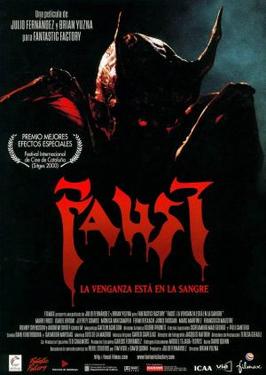
Faust: Love of the Damned is a 2000 Spanish English-language superhero horror film directed by Brian Yuzna. It is adapted from a screenplay by David Quinn and Miguel Tejada-Flores based on the comic book of the same name by Tim Vigil and David Quinn. It was produced by Ted Chalmers, Carlos, Julio and Antonio Fernández, Bea Morillas, Miguel Torrente and Brian Yuzna. It premiered at the Sitges International Fantastic Film Festival on 12 October 2000.
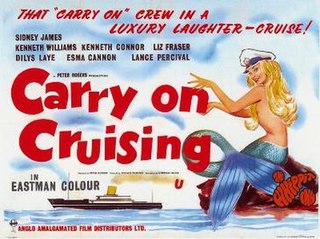
Carry On Cruising is a 1962 British comedy film, the sixth in the series of 31 Carry On films (1958–1992). It was based on an original story by Eric Barker. P&O – Orient Lines were thanked in the credits. Regulars Sid James, Kenneth Williams and Kenneth Connor appear in the film, whereas Joan Sims and Charles Hawtrey do not. Sims took ill shortly before filming began and was replaced by Dilys Laye, making her Carry On debut, at four days' notice. Hawtrey was dropped for demanding star billing, but returned for the next entry, making this the only entry during Hawtrey's 23-film run which he missed. Sims returned two years later in Carry On Cleo. Liz Fraser notches up the second of her four appearances here. Lance Percival makes his only appearance in the series in Carry On Cruising, playing the ship's chef, the role originally designated for Hawtrey. The Australian actor Vincent Ball also makes his first, of two, Carry On appearances. This was the last film to have its screenplay written by Norman Hudis. This film was notable for being the first in the series to be filmed in colour. The film was followed by Carry On Cabby 1963.

Extreme Prejudice is a 1987 American neo-Western action thriller film directed by Walter Hill, from a screenplay by Harry Kleiner and Deric Washburn, from a story by John Milius and Fred Rexer. It stars Nick Nolte and Powers Boothe, with a supporting cast including Michael Ironside, María Conchita Alonso, Rip Torn, William Forsythe, and Clancy Brown.

Guns for San Sebastian is a 1968 French Western film based on the 1962 novel A Wall for San Sebastian, written by Rev. Fr. William Barnaby "Barby" Faherty, S.J. The film is directed by Frenchman Henri Verneuil, and stars Anthony Quinn, Anjanette Comer and Charles Bronson. The score is by Ennio Morricone, who would then use his work in this film as an inspiration for the main theme in The Mercenary. Filming took place in Sierra de Órganos National Park in the town of Sombrerete, Mexico It was made as a co-production between France, Italy, and Mexico. It is a rare instance of a French Western actually being shot in Mexico, instead of substituting Spain or some similar European location.

Kinjite: Forbidden Subjects is a 1989 American action thriller film starring Charles Bronson and directed by J. Lee Thompson. As Thompson's final film, it was the last project he and Bronson did together—a long and famed Hollywood collaboration. The word "kinjite" (禁じて) translates to English as "forbidden move", hinting at the subject matter.
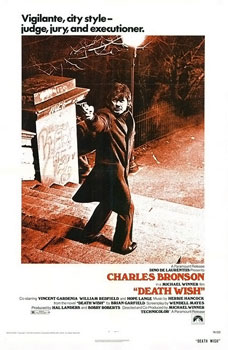
Death Wish is a 1974 American vigilante action film directed by Michael Winner. The film, loosely based on the 1972 novel of the same title by Brian Garfield and the first film in the Death Wish film series, stars Charles Bronson as Paul Kersey, alongside Hope Lange, Vincent Gardenia, William Redfield, Kathleen Tolan and Christopher Guest. In the film, Paul Kersey, an architect leading a peaceful life, resorts to vigilantism after his wife is murdered and daughter raped during a home invasion.
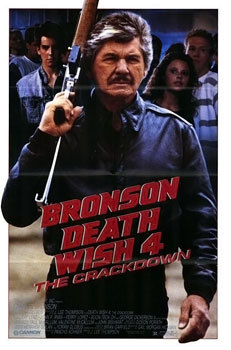
Death Wish 4: The Crackdown is a 1987 American vigilante action-thriller film, and the fourth installment in the Death Wish film series. The film was directed by J. Lee Thompson, and features Charles Bronson, who reprises his leading role as Paul Kersey. In the film, Kersey is once again forced to become a vigilante after his girlfriend's daughter dies of a drug overdose. He is recruited by a tabloid owner, Nathan White to take down various crime figures of the Los Angeles drug trade.

10 to Midnight is a 1983 American neo noir-thriller-horror film directed by J. Lee Thompson from a screenplay originally written by William Roberts. The film stars Charles Bronson in the lead role with a supporting cast that includes Lisa Eilbacher, Andrew Stevens, Gene Davis, Geoffrey Lewis, and Wilford Brimley. 10 to Midnight was released by City Films, a subsidiary of Cannon Films, to American cinemas on March 11, 1983.

Caboblanco is a 1980 American drama film directed by J. Lee Thompson, starring Charles Bronson, Dominique Sanda and Jason Robards. The film has often been described as a remake of Casablanca.
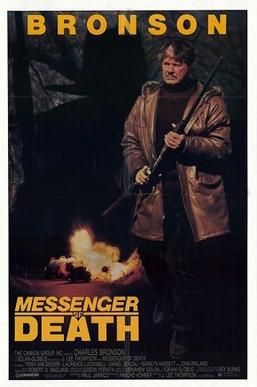
Messenger of Death is a 1988 American vigilante action thriller film starring Charles Bronson. It is about an attempt by a water company to start a family feud among fundamentalist Mormons to take the family's land for the company.

The Shocking Miss Pilgrim is a 1947 American musical comedy film in Technicolor written and directed by George Seaton and starring Betty Grable and Dick Haymes.

Adieu l'ami is a 1968 French-Italian heist crime film directed by Jean Herman and produced by Serge Silberman, with a screenplay by Sebastien Japrisot. The film was a great success in Europe and made Charles Bronson a star there after a career as a supporting actor in Hollywood.

Torment is a 2013 Canadian horror film directed by Jordan Barker. The film had its world premiere on October 11, 2013, at the Screamfest Horror Film Festival. It stars Katharine Isabelle as a woman who must try to save her step-son from an insane family.
R. Lance Hill is an American screenwriter and novelist. He is best known for writing the 1989 cult film Road House, as well as the novel and screenplay for The Evil That Men Do. Hill frequently used the pseudonym David Lee Henry while in Hollywood.


















